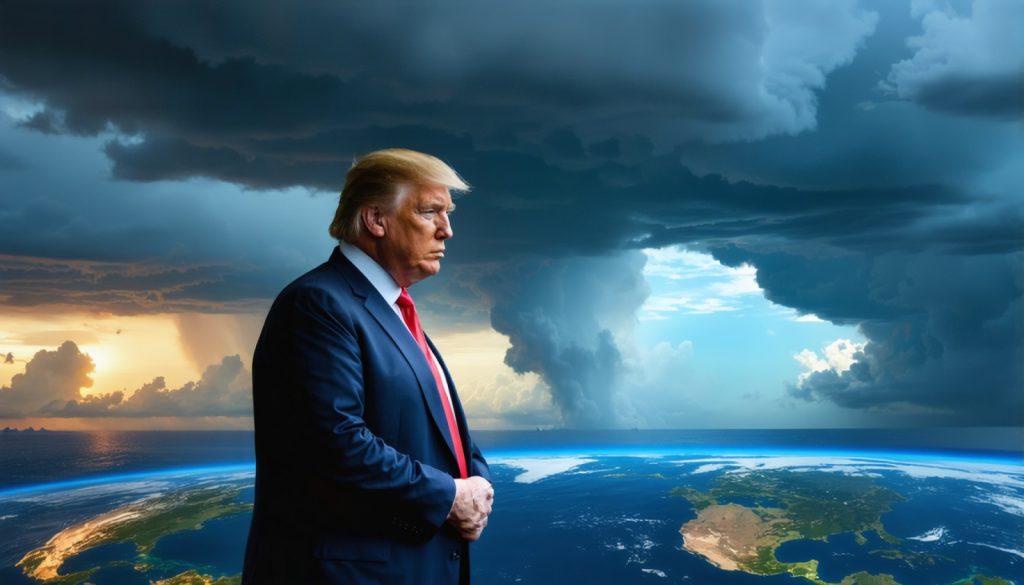
- President Trump has excluded tech products like smartphones, laptops, and computer components from tariffs, benefiting consumers and major companies like Apple Inc.
- This decision aims to balance protective trade measures with the critical role of technology in economic stability amid U.S.-China trade tensions.
- The tech industry avoids potential cost hikes, unlike other sectors, such as automotive, facing high tariffs.
- AI innovations in California highlight the blurring lines between digital and real-world experiences.
- Rivian’s U.S. supply chain strategy and Tesla’s international expansion with the Model Y reflect broader trade dynamics.
- The evolving landscape shows that global trade involves managing complex relationships and regulatory challenges alongside technological progress.
Under a sky darkened by the looming specter of tariffs, an unexpected respite has emerged for the tech industry. In a surprising maneuver, President Donald Trump has maneuvered around imposing tariffs on a plethora of tech products, many of which are household staples. This decision carves out exemptions for items that form the bedrock of our digital lives—smartphones, laptops, hard drives, and an array of computer components—shields them from punishing levies.
These exclusions, detailed by U.S. Customs and Border Protection, reverberate through both individual homes and global markets. For consumers glued to their devices, it’s a direct reprieve, allowing uninterrupted access to technology without the fear of inflating costs. For major players like Apple Inc., the decision is a lifeline, potentially averting a cascade of financial repercussions and maintaining their delicate pricing structures in a fiercely competitive space.
The Bigger Picture: Shifting Trade Currents
Trump’s strategic exclusion of tech from his sweeping tariffs may be an echo of the broader geopolitical ballet between the United States and China. It underscores an effort to maintain a balance between adhering to protective trade measures and acknowledging the essential role of technology in economic stability. While some sectors brace against the tide of tariffs, the tech community finds itself buoyed by this reprieve, dodging a 25% increase initially voted for automotive products and the global 10% tariff baseline.
Yet, alongside the tariff debate, another narrative unfolds on the streets of California, where AI-generated voice clips of tech icons Elon Musk and Mark Zuckerberg have created a tech-infused soundscape, blending the boundaries between reality and the digital future. Hacked crosswalk buttons offer an odd snippet of what technology can achieve—both whimsical and disconcerting.
Trade’s Echo Across Industries
This unexpected decision ripples through various sectors beyond personal electronics. In the automotive realm, Rivian’s overt focus on a U.S.-centric supply chain hints at strategic pivots necessitated by strained global trade relations. Meanwhile, Tesla’s new Model Y iteration, now sighted in Mumbai, mirrors growing aspirations and the geo-expansion ambitions of automakers.
The key takeaway from this intricate web of policy decisions and technological advances is clear: trade isn’t just about goods crossing borders. It’s about relationships, foresight, and the nuanced interplay of innovation and regulation. As the digital age advances, decision-makers must deftly navigate these currents, ensuring that progress remains at the forefront of our global tapestry.
Tech Tariffs Averted: What This Means for Consumers and the Industry
The recent decision by President Donald Trump to exclude certain tech products from sweeping tariffs offers a significant reprieve for both consumers and the tech industry. These exemptions prevent potential price hikes on essential items such as smartphones, laptops, and other computer components, directly impacting household budgets and market stability. Here’s an in-depth analysis of what this means for various stakeholders:
Understanding the Immediate Impact
1. Consumer Benefits and Economic Relief
– Stable Pricing: Consumers can continue to purchase technology at current prices without sudden inflation, thereby maintaining economic balance at a household level.
– Access to Technology: With tariffs lifted, the accessibility of cutting-edge technology remains steady, supporting everything from remote education to telecommuting.
2. Tech Industry Dynamics
– Apple and Major Corporates: Companies like Apple benefit by avoiding cost increases that would disrupt their pricing structures and market competitiveness.
– Innovation Sustenance: By keeping procurement costs in check, tech companies can allocate resources more effectively towards research and development, fostering innovation.
The Wider Geopolitical Context
3. U.S.-China Relations
– Strategic Maneuvering: The tariff exemption can be seen as part of broader U.S. efforts to navigate complex trade relations with China while protecting vital tech sectors.
– Global Trade Stability: This move underscores the importance of tech products in maintaining digital and economic stability across global markets.
Beyond Tech: Industry-wide Implications
4. Automotive Sector Adjustments
– Rivian’s Domestic Focus: Reflects strategic shifts in supply chains, emphasizing reliance on domestic resources amidst global trade uncertainties.
– Tesla’s Expansion Goals: Demonstrates how companies are adapting to geopolitical constraints, exploring markets such as India for wider footprint and market penetration.
Future Outlook and Strategic Takeaways
5. Expectations for Tech Products
– Market Forecasts: Analysts anticipate steady growth in tech sales as stable prices encourage continued consumer spending.
– Innovation Potential: Freed from the burden of tariffs, companies can prioritize emerging technologies like AI, IoT, and 5G infrastructure.
6. Navigating Trade Policy
– For Policy Makers: Continuous evaluation of trade policies to balance protectionism with the need for innovation is essential.
– For Businesses: Proactively adapting to potential policy shifts can safeguard against unforeseen economic impacts.
Practical Tips for Consumers
– Prioritize Purchases: With the tech tariff uncertainty alleviated, consider revisiting purchase plans, especially for high-ticket items like laptops or smartphones.
– Monitor Market Trends: Stay informed about potential policy changes that could impact prices or availability of tech products in the future.
Conclusion: Staying Informed and Prepared
As the digital age progresses, staying ahead of geopolitical changes and their impact on the tech landscape is crucial. By understanding these dynamics, consumers can make informed decisions, while businesses can strategically plan for a stable and innovative future.
For more insights on market trends and technological advancements, visit Apple and Tesla.
Recommendations
– Stay Updated: Regularly follow tech news for insights into product launches and pricing changes.
– Invest in Technology Wisely: With tariffs lifted, it’s an opportune time to consider upgrading to newer tech models.
In this rapidly changing landscape, knowledge is power—understanding the interplay of trade policy and tech developments is invaluable for making savvy decisions and staying ahead.



